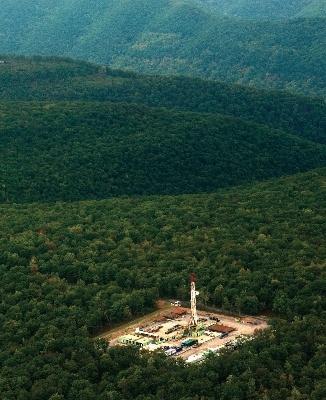
Pennsylvania’s Department of Conservation and Natural Resources this month released its first report that describes efforts to “track, detect and report” on the impacts of gas development on the state’s forest lands.
The 265-page “Shale-Gas Monitoring Report” is just that: a comprehensive and carefully worded document about the results of the monitoring that the state has conducted since 2011, while avoiding the use of the term hydraulic fracturing, or "fracking," almost entirely. It’s “shale-gas development,” not fracking here, and there’s a raft of “key findings and points,” but no conclusions.
"People may have different perspectives on how monitoring is defined, but they want to know that staff is on the ground observing and managing gas development activity that is occurring in our state forests," explained Ellen Ferretti, secretary of DCNR.
"The intent of the report is to present information in as objective a manner as possible. Oftentimes trends or effects are not evident for years or decades. Despite that, there are some findings that can be gleaned from this initial report," Acting Deputy Secretary for Parks and Forestry Dan Devlin added.
Overall, approximately 1.5 million acres of state forest are underlain by Marcellus Shale, according to the report. Of that acreage, 44 percent (673,000 acres) is available for gas development either through bureau-issued leases (386,000 acres) or severed lands development (287,000 acres). “Modern shale-gas leases restrict surface disturbance in sensitive areas and limit overall surface disturbance to approximately 2 percent of the acreage within the lease tract,” the report reads. About 15 percent of all shale gas produced in Pennsylvania comes from state forest lands.
Some findings from the report include:
- Initial water monitoring results “have not identified any significant impacts due to shale-gas development. This is based on one round of field chemistry sampling throughout the shale-gas region and over a year of operation for 10 continuous monitoring devices in key watersheds. At this early stage, the data collected are primarily for establishing baseline conditions.”
- “Approximately 1,486 acres of state forest has been converted through 2012 to facilitate gas development; a number that is lower as a result of a management decision to place this activity within or adjacent to existing infrastructure or existing disturbances where it is more noticeable to the public, but requires less forest disturbance."
- Short-term air sampling at several locations around the state “has detected natural gas constituents and associated compounds in the vicinity of shale-gas operations. These compounds were not detected at concentrations that would likely cause health-related impacts, although some were detected at levels which would produce an odor.”
- “Invasive species are a concern as areas of disturbance tend to create conditions conducive to invasion of unwanted plant species or pests. The report clearly shows that invasive species need to be carefully managed and controlled. DCNR leases require that companies address invasive species.”
Perhaps all one really needs to know about this report are findings related to revenue:
- The pre-shale-gas period of oil and gas activity provided a total income to the state of approximately $153.6 million. The shale-gas period (through 2012, for the purposes of the report) has provided $582.3 million in revenue. The combined total of all revenue from the oil and gas lease program from 1947 to the end of 2012 has been approximately $735.9 million.
- The influx of shale-gas production revenue began in 2009 when most of the wells that had been first proposed in 2007, 2008 and early 2009 were drilled and connected to the pipeline system and gas was delivered to the market.
- Royalty income is just beginning to come to DCNR from the hundreds of new shale-gas wells on state forest land.
- Steady revenue growth from gas extraction is expected to continue for the next decade as the full development of the leases comes to a conclusion.
While “surface disturbance” appears small and it’s a relatively small amount of forest land at issue, the revenue potential is significant.
Fracking is a controversial topic, but the state’s report avoids any controversy in the spirit of objectivity and information, which for some may make it controversial, or ignorable. It is described as “snapshot in time,” and while the report’s findings are not catastrophic, neither are they benign. But how useful is it and how much clarity does it provide? Perhaps the next snapshot will be clearer.
Image: Courtesy of Martha Rial in the DCNR Shale-Gas Monitoring Report

Writer, editor, reader and generally good (okay mostly good, well sometimes good) guy trying to get by.














